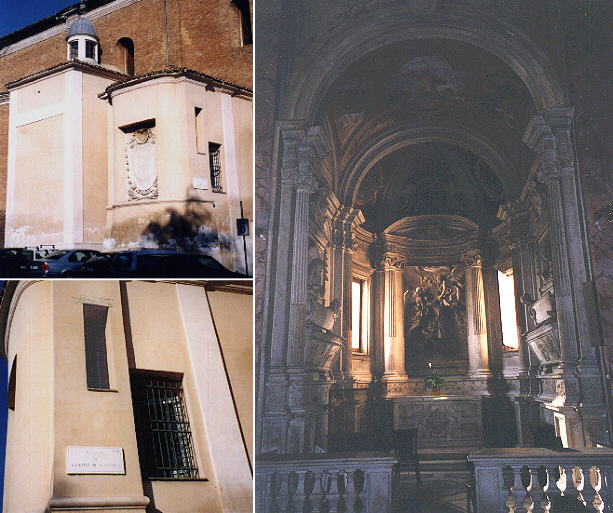  Three chapels by Gian Lorenzo Bernini
Cappella Raimondi S. Pietro in Montorio is a XVth century church with very small chapels, not much larger
than a niche in the wall. The right side of the church is adjoining the cloister of the monastery so it is not possible
to modify the chapels on that side. On the left side there were no other buildings, so in the early XVIIth century Carlo Maderno
expanded one of the chapels and in 1642-46 Gian Lorenzo Bernini did the same to build a chapel
for the Raimondi family.
Funeral monuments were in general of two types: one derived from the Roman and medieval tradition and showed the dead lying on a sarcophagus, the other derived from Michelangelo's Medici tombs in Florence and had a triangular shape with the dead between two other statues. Only a large chapel could accomodate such monuments and so the decoration of the walls of the chapels was in general made of paintings (either frescoes or canvasses). For this chapel Bernini adopted a different solution, by designing a funeral monument which did not require a lot of space and marble. Only the upper part of the body of the dead is visible as if he were behind a kneeling-stool. On the altar there is a relief by a Bernini scholar (Francesco Baratta) showing the Assumption of St Francis. Reliefs were very popular in the XVIIth century as they were seen as a perfect combination of picture and sculpture: Bernini himself was not very celebrated for his reliefs, but his rival Alessandro Algardi excelled in this technique.
Of the two busts (again by a Bernini's scholar, Andrea Bolgi) the one on the right side
is very interesting because it looks towards the entrance of the chapel, as if he was inviting
you to enter. Bernini's sculptures with very few exceptions always show an action: a classic example
is the comparison between Michelangelo's (or Donatello's or Verrocchio's) David and Bernini's David, whom
we see in the act of throwing the stone. Another interesting feature of these monuments is the space
for a small relief: in this case the reliefs are not related to the lives of the dead, but this
design will be adopted in many other funeral monuments, in particular the papal monuments in St Peter's to celebrate
a particular episode of their lives.
Go and see another work by Gian Lorenzo Bernini or go to my Home
Page on Baroque Rome or to my Home Page on Rome
in the footsteps of an XVIIIth century traveller.
|
All images © 1999 - 2003 by Roberto Piperno. Write to romapip@quipo.it

